"Unspoilt, beautiful, and dramatic destination for archaeology, bird-watching, and spectacular hill walking.”
National Geographic
The Aran Islands has the distinction of being granted One of The World’s Top Island Destination by National Geographic, described as, “Unspoilt, beautiful, and dramatic destination for archaeology, bird-watching, and spectacular hill walking.”
The Islands are an extension of the Burren with its unique limestone landscape of fossils, rock formations and archaeological sites and rich flora. There are arctic and alpine plants growing alongside Mediterranean orchids and maidenhair fern. Lichens such as Lugworth and Parmeliella thrive here. These species are the first to disappear in the presence of pollution and are a good indication that the air on the Island is pure.
The film ‘Man of Aran 1934’ shows how sand and seaweed made the cultivation of crops possible in this barren landscape. The potato was a staple diet over centuries and having your own land to sow potatoes was a treasured possession that ensured food for the table and for bartering for turf and other needed essentials. You can view this on our Living Room TV.
Dún Aonghasa is probably the most spectacular ring fort in Ireland dating back to close to 3000 years. There are three more ring forts left on Inis Mór and two on Inis Meáin and one on Inis Oirr. The island was once known as the island of saints and scholars and many remnants of their monasteries and holy wells still remain.
Our Lodge is in an ideal location to explore the island. Dún Aonghasa and Poll na bPéist are nearby as well as a Blue Flag beach for swimming and canoeing. Walking and cycling will allow you explore the island along green roads and narrow bóithríní which transect the limestone pavement.
What we offer!
Our location is different to the environment that you are familiar with. Take your time take in all that is new. Tá fáilte romhat!
You may have come away from the hustle and bustle of modern life to slow down, look around you, refresh and relax among the people of Inis Mór. We are an extension of the Burren in Co Clare and when you visit the Cliffs of Moher - the Islands are a must see extension. Water percolates right through the rock and into the sea preventing the formation of the typical landform: the bog. Peat for fires had to be brought across from Connemara for centuries and bartered for potatoes grown in fertile well drained soil on the Island as well as for cured rock fish, pollock and mackerel. The flora and fauna of Inis Mór includes Mediterranean and Alpine species that attract many tiny multicoloured butterflies.
You are in an Irish-speaking part of our country and you will be most welcome to practice the Irish you have and indeed build on what you have. We can provide assistants and teachers as required. Má tá suim ag do ghrúpa Gaeilge a labhairt beidh fáilte romhat!
Most families on the island have a small farm with cows, horses, donkeys, goats and some sheep. In the past their footprint on the environment was light because they depended on their environment for everything. They grew their own food, caught their own fish made their own baskets using willow etc..
We suggest that you use Our Lodge to explore this unique Island landscape at your own pace. We can organise guides as required. Good runners or walking boots are a must!. The runners are lighter and may be better to allow you choose your step as you make your way over uneven terrain.
Starting off with the attractions close by is advisable. A walk to Dún Aonghasa could be your first expedition to allow you get your bearings and view craft shops and coffee shops at Cill Mhuirbhigh.
A swim at our Blue Flag can be an essential part of your day. Keeping an eye on tides as well as the weather forecast will be important as sometimes we can have the four seasons in one day. While some prefer swimming at high tide others prefer low tide – both are possible. Diving from the pier is only safe at high tide. Canoes are available to rent for interested parties.
Cycling on the low road to the seal colony can be a most enjoyable experience. There are few hills and getting used to cycling again could add to the holiday experience. We offer bike rental.
Walking to Poll na bPéist at a leisurely pace is recommended. You could look up ‘Red Bull Cliff Diving’ on YouTube; however remember that you are not a trained Red Bull Diver and diving in is not the thing to do. Some go down to sea level and dive in at high tide; however this can only be done at your own risk in perfectly calm weather. The rock face is very sharp in certain places and if wet, very slippery.
After visiting Dún Aonghasa, the Wormhole and the seal-colony you are getting to know the Island and you will plan for longer distances walking or cycling or even carriage rides if you desire. Many like to walk the green road into the village of Kilronan. This road is generally for walkers and cyclists and can be the oasis of peace desired.
Other possible activities : There is an Inis Mór Scuba diving school – for scuba diving ; contact@ diveacademy.ifo or phone 353(0)857257260
Sea-angling is also possible and fishing rods are available to rent to fish from the shore.
Our seashores are excellent places to explore , see, study and collect barnacles, periwinkles sea-shells, crabs, carageen moss etc. You can also order carageen moss for dessert.
Knitting – learn knitting from the folks at ‘An Tuirne Island Handknits’ at Cill Mhuirbhigh.
Guided walks and bus tours will be available as required.
We can facilitate a farm walk - we can show you how land was made on the Island and guide to you rebuild a stone wall; identify the breed of animal kept on the Island; fish for rock-fish like generations of Islanders have done in the past.
Towards the end of your stay, to treat yourself, you can organise a carriage ride or a pony and trap along the low road to Cill Rónáin.
If you have a particular area of interest please contact us and we will do our best to get the needed specialist.
‘Bain taitneamh as a bheith ag déanamh aeir.'
Take a Walk on the Wild Side
Here is a full week of activities you could do.
Day 1
Our Lodge is situated 0.5 km from the Blue Flag Beach at Cill Mhuirbhigh.
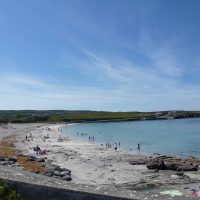
So hit the beach: Kilmurvey beach is a beautiful white sandy beach about 0.5 km from our door. It’s suitable for young and old. On a sunny day the water is crystal clear and very inviting! There is no strong current. It’s an opportunity of a lifetime. You will be glad you did! If you wish to dive in – well then the local pier may be suitable at high tide.
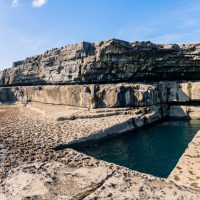 We are situated 1.1 km from Poll na bPéist
We are situated 1.1 km from Poll na bPéist
The Worm Hole is an intriguing natural feature located on the south eastern side of our Lodge close to Dún Aonghasa. This rectangular pool looks like it is man-made it is a naturally occurring phenomenon. Seen from above, the sea and waves flow into a rectangular pool beneath the cliffs, making it a visually stunning place to experience. The Worm Hole has also been a venue for the Red Bull Cliff Diving Championships. Access to Poll na bPeist is through the village of Gort na gCapall. The path is quite uneven as the path built in the 1930s has been washed away and not replaced. Good walking shoes will be required to help you pick your step. The area can be calm and peaceful or wet, windy, and slippery and time and care should be taken. Enroute to Poll na bPéist you will be able to see ‘The Liam O Flaherty Memorial Garden’ built in 2006.
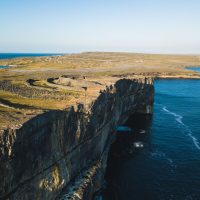 We are 1.7 km from Dún Aonghasa. Dún Aonghasa is in full view from our Lodge.
We are 1.7 km from Dún Aonghasa. Dún Aonghasa is in full view from our Lodge.
This is arguably the ‘main attraction on Inis Mor. It is an incredibly impressive semi-circular fortification complex built on the highest point of the cliff on the southern coastline. Dún Aonghasa is considered one of the most important pre-historic sites in Western Europe; it became a national monument at the end of the 19th Century and is conserved by the Heritage Services. Covering an area of 14 acres, the interior of the hill fort is divided into an outer, middle and inner enclosure by three curved walls terminating at the cliff face. Outside the middle enclosure the fort was fortified with a large broad band of closely set pillars (chevaux de fries). Visitors to the fort should first drop in at the Visitors Centre before exploring the fort itself, which is about 1km away. Due to the uneven terrain, it may be difficult for some to reach the site. Those that visit the fort though will be rewarded with views of not only this wonderful Bronze Age structure, but amazing views from the cliffs. Teampall Mac Duach is located at the base of the famous Dún Aonghasa and well worth a visit. You'll find Craft and Coffee shops nearby.
Day 2
Our Lodge is situated 1.8 km Clochán na Carraige:
A clochán is a stone-roofed bee-hive hut. Though many exist on the island, the one at Struthán, near Kilmurvey, is the best preserved example.
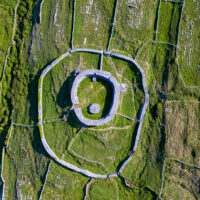 Our Lodge is situated 4 km Dún Eoghanachta.
Our Lodge is situated 4 km Dún Eoghanachta.
This fort can be found on the western head of the island in the townland of Eoghanacht, south of the village of Sruthán. It consists of a single circular two-terraced wall of impressive height. The remains of several Clochain (stone houses) lie inside. The fort takes its name from the Eoghanachta tribe of Munster who were associated with the island in medieval times.
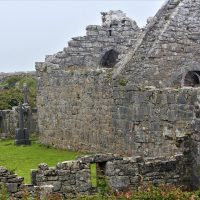 Our Lodge is situated 6 km from Na Seacht dTeampaill (the Seven Churches)
Our Lodge is situated 6 km from Na Seacht dTeampaill (the Seven Churches)
The ‘Seven Churches’ was once one of the biggest monastery and pilgrimage centres found on the Irish west coast. Thought to have been founded by Breacán, a contemporary of St. Enda, the complex is situated in the village of Eoghanacht. Although known as the seven churches, there are in fact only two churches, with the other buildings having once served other purposes. Of the churches, Teampall Bhreacáin (St Brecan’s Church) was constructed sometime between the 8th-13th century in different phases. It is known for its masonry work, and has an impressive arch, nave and chancel. The other church, Teampall an Phoill (the Church of the Hollow), is a much smaller church and far simpler in style. Constructed much later in the 15th century, penitential bed remains along with decorated cross fragments can be seen. In one corner of the site, there are some inscribed stones and graves, one of which says “ VII ROMANI” (The Seven Romans).
Day 3
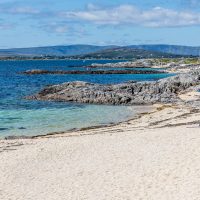 Our Lodge is situated 2.2 km from the seal colony.
Our Lodge is situated 2.2 km from the seal colony.
It has has become increasingly popular with visitors to the Aran Islands over the years. It is situated along the coastal road east of Kilmurvey beach, enroute to Kilronan. On a clear day and with the tide in your favour, you will be able to see many seals bathing. They like lying in the sun at low tide. A nearby lake is home to swans, ducks, and some rare birds, making the trip here doubly worthwhile. Bring binoculars if you have them. Not only will they be useful for looking at the Seal Colony and bird watching, but they will also be useful when exploring the rest of the island.
Our Lodge is situated 5 km from Teampall Chiaráin.
Teampall Chiaráin is in the village of Mainistir north west of Kilronan. It is said to have been founded by St Ciarán of Clonmacnoise who studied here under St Enda before sailing up the Shannon to establish his foundation at Clonmacnoise. The church which dates from about 12th century stands on the old site of Mainistir Chonnacht. Several cross-decorated slabs stand near the church. These may be old Tearmann crosses (boundary crosses). The most striking one is immediately to the east of the church. It is well decorated and has a hole in it indicating it may have been used as a sundial. Traditionally islanders draw a handkerchief or scarf through the hole for luck or fertility.
Our Lodge is situated 6 km from Teampall Rónán which is situated in the village of Cill Rónáin.
Day 4
Our Lodge is situated 2 km from Leaba Dhiarmada agus Gráinne.
Leaba Dhiarmada agus Gráinne is a megalithic wedge tomb dating back to 2000 B.C. and is a burial place of early farmers. Wedge tombs are the earliest known monuments on Aran.
Our Lodge is situated 1.9 km Teampall an Cheathrair Álainn.
Teampall an Cheathrair Álainn is a simple but beautiful 15th Century church, dedicated to the 'Four Beautiful Saints': Fursey, Brendan, Conal and Berchan, who are said to be buried nearby.
Our Lodge is situated 4 km from Dún Eochla
Dún Eochla is a superb stone ringfort located at the highest point on Inis Mór. The inner walls measure approximately 5 metres in height, and over 3 metres in depth. With its fantastic location and remarkable condition it is well worth a visit. The fort has an almost 360 degree view of the island. It has been estimated that Dún Eochla was built sometime between 550 and 800 A.D . Communities lived in Clocháin around fort and many remnants of these Clocháin remain.
Day 5
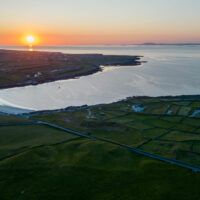 Our Lodge is situated 9 km Dún Dúchathair
Our Lodge is situated 9 km Dún Dúchathair
Dúchathair lies one and a half miles west off Killeany via the cliffs. Originally it was probably the biggest fort on the island, though now it is smaller than the one at Dún Aonghus. Visitors can enjoy the solitude of it in contrast to Dún Aonghus. It’s understood that the name comes from the darker coloured limestone that is characteristic of this area. The fort consists a terraced wall surrounding the remains of some early dwelling houses known as Clocháns.
Our Lodge is situated 8 km from Tobar Cholmcille
Tobar Cholmcille is situated in Cill Éinne and is visited by many on the 9th of June each year to say special prayers to St Colmcille.
Our Lodge is situated 9 km from Arkin Castle.
The ruins of this tower house stands on the southern bank of Killeany Bay. This castle was probably built by John Rawson, to whom Elizabeth I had granted the islands in 1588. It was fortified by Lord Clanrickard against the Cromwellians who gained control of it in 1652, lost it and recaptured it in 1653
Our Lodge is situated 9.1 km from The Round Tower
The Round Tower was originally about 35 metres high and dates back to the 9th Century. Unfortunately, it was damaged during Cromwellian times.. Presently only stands at 4 metres.It is believed that St Enda’s Monastery was in this area and that the stones were used to build Airckn Castle.
Our Lodge is situated 9.2 km from Teampall Bheanáin
This tiny church overlooking Killeany Bay and the villages of Kilronan and Killeany is claimed to be the smallest church in the world at 3.7m x 1.8m. The roofless remains of the church are located on the eastern headland of Inis Mór and is a great example of one of the earliest Christian churches. It is oriented on a north-south axis -- instead of the more common east-west axis of most Christian structures -- as it was built on a particularly exposed and windy site. There is a small window on its west side. Nearby are the remains of a cashel wall, a dwelling structure, and a small beehive hut (clochán).
Day 6
Our Lodge is situated 9.3 km from Teaghlach Éinne .
Teaghlach Éine is a little church, half buried in sand in Cill Einne graveyard on the south-east end of the island. The graveyard is at least 1,500 years old and is still in use as the main burial ground of the Island. It contains the grave of St. Enda who died around 535 A.D. and is the patron saint of Inis Mór.
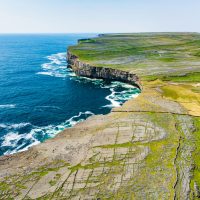 Our Lodge is situated 11 km from The Puffing Holes:
Our Lodge is situated 11 km from The Puffing Holes:
The Puffing Holes are a series of holes found at the top of the Inis Mor cliffs, which have channels leading down through the rock and into the sea below. As the waves rush into the cliffs, water is pushed up through the channels and then spouts out up through the holes. Take care when in the general area, as there may be unmarked holes that need avoiding!
Day 7
Stay in bed, have a coffee, read a book or get out and discover what else the Island has to offer.

